Related Research Articles

Pollen is a powdery substance produced by seed plants. It consists of pollen grains, which produce male gametes. Pollen grains have a hard coat made of sporopollenin that protects the gametophytes during the process of their movement from the stamens to the pistil of flowering plants, or from the male cone to the female cone of gymnosperms. If pollen lands on a compatible pistil or female cone, it germinates, producing a pollen tube that transfers the sperm to the ovule containing the female gametophyte. Individual pollen grains are small enough to require magnification to see detail. The study of pollen is called palynology and is highly useful in paleoecology, paleontology, archaeology, and forensics. Pollen in plants is used for transferring haploid male genetic material from the anther of a single flower to the stigma of another in cross-pollination. In a case of self-pollination, this process takes place from the anther of a flower to the stigma of the same flower.

Allergies, also known as allergic diseases, are a number of conditions caused by hypersensitivity of the immune system to typically harmless substances in the environment. These diseases include hay fever, food allergies, atopic dermatitis, allergic asthma, and anaphylaxis. Symptoms may include red eyes, an itchy rash, sneezing, a runny nose, shortness of breath, or swelling. Food intolerances and food poisoning are separate conditions.
An allergen is a type of antigen that produces an abnormally vigorous immune response in which the immune system fights off a perceived threat that would otherwise be harmless to the body. Such reactions are called allergies.
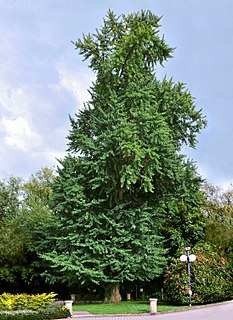
Ginkgo biloba, commonly known as ginkgo or gingko also known as the maidenhair tree, is a species of tree native to China. It is the last living species in the order Ginkgoales, which first appeared over 290 million years ago. Fossils very similar to the living species, belonging to the genus Ginkgo, extend back to the Middle Jurassic approximately 170 million years ago. The tree was cultivated early in human history and remains commonly planted.

Morus, a genus of flowering plants in the family Moraceae, consists of diverse species of deciduous trees commonly known as mulberries, growing wild and under cultivation in many temperate world regions. Generally, the genus has three well-known species ostensibly named for the fruit color of the best-known cultivar: white, red, and black mulberry, with numerous cultivars, The name "white mulberry" came about because the first specimens named by European taxonomists were a cultivated mutation prized for their white fruit, but wild trees bear black fruit like other mulberries. White mulberry is native to South Asia, but is widely distributed across Europe, Southern Africa, South America, and North America. The species most preferred by the silkworm, Morus alba is regarded as an invasive species in Brazil and the United States.
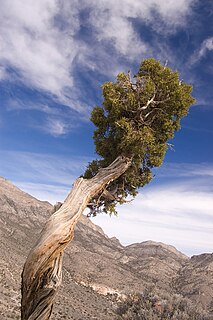
Junipers are coniferous trees and shrubs in the genus Juniperus of the cypress family Cupressaceae. Depending on taxonomic viewpoint, between 50 and 67 species of junipers are widely distributed throughout the Northern Hemisphere, from the Arctic, south to tropical Africa, throughout parts of western, central and southern Asia, east to eastern Tibet in the Old World, and in the mountains of Central America. The highest-known juniper forest occurs at an altitude of 4,900 m (16,100 ft) in southeastern Tibet and the northern Himalayas, creating one of the highest tree-lines on earth.
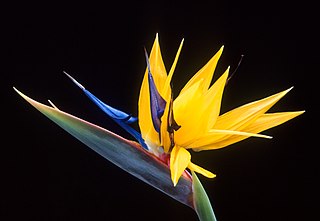
Strelitzia is a genus of five species of perennial plants, native to South Africa. It belongs to the plant family Strelitziaceae. The genus is named after Queen Charlotte of the United Kingdom. A common name of the genus is bird of paradise flower/plant, because of a resemblance of its flowers to birds-of-paradise. In South Africa, it is commonly known as a crane flower and is featured on the reverse of the 50-cent coin. It is the floral emblem of the City of Los Angeles; two of the species, S. nicolai and S. reginae, are frequently grown as houseplants.

Taxus is a genus of coniferous trees or shrubs known as yews in the family Taxaceae. They are relatively slow-growing and can be very long-lived, and reach heights of 2.5–20 metres (8.2–65.6 ft), with trunk girth averaging 5 metres (16 ft). They have reddish bark, lanceolate, flat, dark-green leaves 10–40 millimetres long and 2–3 mm broad, arranged spirally on the stem, but with the leaf bases twisted to align the leaves in two flat rows either side of the stem. The oldest known fossil species are from the Early Cretaceous.
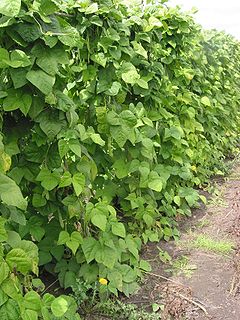
Phaseolus is a genus of herbaceous to woody annual and perennial vines in the family Fabaceae containing about 70 plant species, all native to the Americas, primarily Mesoamerica.

Ragweeds are flowering plants in the genus Ambrosia in the aster family, Asteraceae. They are distributed in the tropical and subtropical regions of the Americas, especially North America, where the origin and center of diversity of the genus are in the southwestern United States and northwestern Mexico. Several species have been introduced to the Old World and some have naturalized and have become invasive species. Ragweed species are expected to continue spreading across Europe in the near future in response to ongoing climate change.

Cupressaceae is a conifer family, the cypress family, with worldwide distribution. The family includes 27–30 genera, which include the junipers and redwoods, with about 130–140 species in total. They are monoecious, subdioecious or (rarely) dioecious trees and shrubs up to 116 m (381 ft) tall. The bark of mature trees is commonly orange- to red- brown and of stringy texture, often flaking or peeling in vertical strips, but smooth, scaly or hard and square-cracked in some species.

Allergic rhinitis, of which the seasonal type is called hay fever, is a type of inflammation in the nose that occurs when the immune system overreacts to allergens in the air. Signs and symptoms include a runny or stuffy nose, sneezing, red, itchy, and watery eyes, and swelling around the eyes. The fluid from the nose is usually clear. Symptom onset is often within minutes following allergen exposure, and can affect sleep and the ability to work or study. Some people may develop symptoms only during specific times of the year, often as a result of pollen exposure. Many people with allergic rhinitis also have asthma, allergic conjunctivitis, or atopic dermatitis.

Abelia is a previously recognized genus that contained about 30 species and hybrids, placed in the honeysuckle family, Caprifoliaceae. Molecular phylogenetic studies showed that the genus was not monophyletic, and in 2013, Maarten Christenhusz proposed the merger of Abelia into Linnaea, along with some other genera. Abelia section Zabelia was raised to the genus Zabelia.

Rhinitis, also known as coryza, is irritation and inflammation of the mucous membrane inside the nose. Common symptoms are a stuffy nose, runny nose, sneezing, and post-nasal drip.

Daucus is a worldwide genus of herbaceous plants of the celery family Apiaceae of which the best-known species is the cultivated carrot. Daucus has about 25 species. The oldest carrot fossil is 1.3 Ma, and was found on the island of Madeira in the Atlantic Ocean.

Podocarpus is a genus of conifers, the most numerous and widely distributed of the podocarp family, the Podocarpaceae. The name comes from Greek πούς + καρπός. Podocarpus species are evergreen shrubs or trees, usually from 1 to 25 m tall, known to reach 40 m (130 ft) at times. The cones have two to five fused cone scales, which form a fleshy, berry-like, brightly coloured receptacle at maturity. The fleshy cones attract birds, which then eat the cones and disperse the seeds in their droppings. About 97 to 107 species are placed in the genus depending on the circumscription of the species.

Strelitzia reginae, commonly known as the crane flower, bird of paradise, or isigude in Nguni, is a species of flowering plant indigenous to South Africa. An evergreen perennial, it is widely cultivated for its dramatic flowers. In temperate areas it is a popular houseplant.
Oral allergy syndrome (OAS) is a type of food allergy classified by a cluster of allergic reactions in the mouth and throat in response to eating certain fruits, nuts, and vegetables that typically develops in adults with hay fever.

Acacia floribunda is a perennial evergreen shrub or tree. It is a species of wattle native to New South Wales, Queensland and Victoria, but is cultivated extensively, and has naturalised in South Australia, Tasmania and Western Australia, and also in Indonesia, Mauritius and northern New Zealand. Common names for it include gossamer wattle, weeping acacia and white sallow wattle. It grows up to 6m in height, but there is a commercial form available which only grows to about 1m tall. Its cream-colored flowers occur in the early Spring.
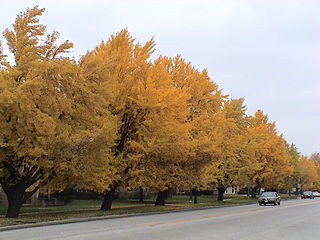
Botanical sexism is a term coined by horticulturist Tom Ogren to describe the planting of male plants instead of female plants of certain dioecious species including: willows, poplars, aspens, ashes, silver maples, pistache, mulberry, pepper tree and other woody plants such as junipers, yew pines, fern pines, wax myrtles, alpine currants, plum yews, and yews According to Ogren, pollen allergies have been amplified due to the planting in urban areas of male clones which increases the amount of pollen in the air. Male plants are commonly used in urban areas because plants with female flowers produce fruits and flowers that litter the landscape. The planting of more female plants would decrease the overall amount of pollen since they do not produce pollen and remove pollen from the air for pollination. The theory has existed since at least the 2000s. Biological sexism is used in the Ogren Plant Allergy Scale (OPALS), which has been adopted by the United States Department of Agriculture. Botanical sexism has found some scientific acceptance as a reason for increased allergies and asthma; however, other scientists have also been critical of it, stating that it only applies to certain trees and is not as widespread as Ogren alleges.
References
- 1 2 3 4 5 Ogren, Thomas Leo (2000). Allergy-Free Gardening . Berkeley: Ten Speed Press. ISBN 1580081665.
- ↑ Hirschlag, Ally (16 May 2020). "How urban planners' preference for male trees has made your hay fever worse". The Guardian. Retrieved 17 May 2020.
- ↑ Harrar, Sari N. "Sick of Sneezing? Allergy-Proof Your Yard". ABC News. Retrieved 3 May 2014.
- ↑ Zacharias, Colleen. "Sneeze, wheeze... solutions, please". Winnipeg Free Press. Retrieved 5 May 2014.
- ↑ "Tom Ogren". Academia. Retrieved 5 May 2014.
- ↑ Ogren, Thomas Leo (2015). The Allergy-Fighting Garden. Berkeley: Ten Speed Press. ISBN 9781607744917.
- ↑ Prakke, Peter (2018). Veterans Gardening Guide. Tellwell Talent. p. 19. ISBN 978-1-77370-342-8.
- ↑ "Canadian Urban Allergy Audit" (PDF). Marketwire.com. Retrieved 3 May 2014.
- ↑ McCusker, Kris. "Urban allergy audit provides glimmer of hope for Toronto allergy sufferers". 680news.com. Retrieved 3 May 2014.
- ↑ Hansen, Jolene. "Put Pollen in its Place". Garden Center. Retrieved 25 June 2016.
- ↑ Ogren, Thomas. "A Plan for Cities Wishing to Reduce Pollen-Allergies and Related Allergic-Asthma". icangarden.com. Retrieved 3 May 2014.
- ↑ "Strategic Plan for Asthma in California" (PDF). cdph.ca.gov. Retrieved 12 May 2018.